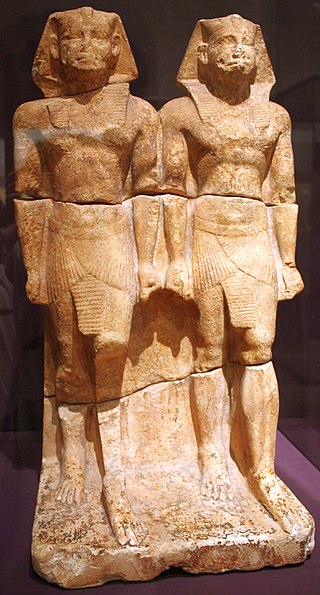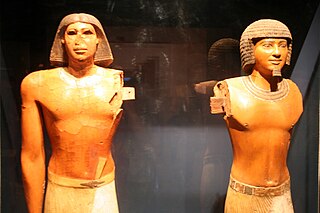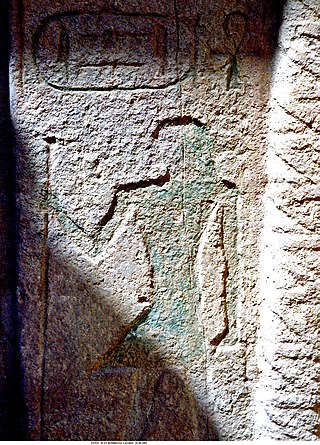Related Research Articles

Pehenuikai was an Ancient Egyptian official of the Fifth Dynasty. His main office was that of a vizier, making him to the most important man at the royal court, only second to the king. Beside being vizier, he was also holding many other important titles, such as Overseer of the treasuries, overseer of the scribes of the king's document, overseer of the double granary and overseer of all royal works of the king.

Neferirkare Kakai was an ancient Egyptian pharaoh, the third king of the Fifth Dynasty. Neferirkare, the eldest son of Sahure with his consort Meretnebty, was known as Ranefer A before he came to the throne. He acceded the day after his father's death and reigned for around 17 years, sometime in the early to mid-25th century BCE. He was himself very likely succeeded by his eldest son, born of his queen Khentkaus II, the prince Ranefer B who would take the throne as king Neferefre. Neferirkare fathered another pharaoh, Nyuserre Ini, who took the throne after Neferefre's short reign and the brief rule of the poorly known Shepseskare.

Djedkare Isesi was a pharaoh, the eighth and penultimate ruler of the Fifth Dynasty of Egypt in the late 25th century to mid-24th century BC, during the Old Kingdom. Djedkare succeeded Menkauhor Kaiu and was in turn succeeded by Unas. His relationship to both of these pharaohs remain uncertain, although it is often conjectured that Unas was Djedkare's son, owing to the smooth transition between the two.

Nyuserre Ini was an Ancient Egyptian king, the sixth ruler of the Fifth Dynasty during the Old Kingdom period. He is credited with a reign of 24 to 36 years depending on the scholar, and likely lived in the second half of the 25th century BCE. Nyuserre was the younger son of Neferirkare Kakai and queen Khentkaus II, and the brother of the short-lived king Neferefre. He may have succeeded his brother directly, as indicated by much later historical sources. Alternatively, Shepseskare may have reigned between the two as advocated by Miroslav Verner, albeit only for a few weeks or months at the most. The relation of Shepseskare with Neferefre and Nyuserre remains highly uncertain. Nyuserre was in turn succeeded by Menkauhor Kaiu, who could have been his nephew and a son of Neferefre.

Ptahhotep, sometimes known as Ptahhotep I or Ptahhotpe, was an ancient Egyptian vizier during the late 25th century BC and early 24th century BC Fifth Dynasty of Egypt. He is credited with authoring The Maxims of Ptahhotep, an early piece of Egyptian "wisdom literature" or philosophy meant to instruct young men in appropriate behavior.

Isesi-ankh was an ancient Egyptian high official during the second half of the Fifth Dynasty, in the late 25th to mid 24th century BC. His name means "Isesi lives". He may have been a son of pharaoh Djedkare Isesi and queen Meresankh IV, although this is debated. Isesi-ankh probably lived during the reign of Djedkare Isesi and that of his successor Unas. He was buried in a mastaba tomb in north Saqqara, now ruined.

Rashepses was a vizier from the Fifth Dynasty of Egypt. Rashepses was vizier under Djedkare Isesi. A letter directed to Rashepses has been preserved. This decree is inscribed in his tomb in Saqqara. As vizier he was one of the most important Ancient Egyptian officials. In his tomb are many titles recorded. It seems that he was first overseer of the scribes of the royal documents, overseer of the two granaries and overseer of all royal works. These are all very important titles, making him an influential official at the royal court. At the final stage of his career he became vizier. The vizier title is only preserved in two letters that are copied on the decoration of the tomb. It seems that most of his tomb was finished and after all that, he was promoted.

Akhethetep was a high dignitary of ancient Egypt who lived during the Fifth Dynasty. Akhethotep and his son Ptahhotep Tjefi were senior court officials during the rule of Djedkare and of Unas (Wenis), towards the end of the 5th Dynasty. Akhethetep's titles included that of a vizier, making him to the highest official at the royal court, only second to the king. He was also overseer of the treasuries, overseer of the scribes of the king's documents and overseer of the granaries. Akhethetep was the son of Ptahhotep. His father was vizier too.

Shemay was an ancient Egyptian official and later vizier toward the end of the 8th Dynasty during the First Intermediate Period, mainly known for being the beneficiary of most of the Coptos Decrees. His career has been interpreted as a glaring sign of the extreme weakness of the central power, forced to bestow great privileges to maintain the loyalty of powerful local governors. Shemay is buried in a mudbrick mastaba just south of Coptos.

Mehu was an Ancient Egyptian vizier who lived in the Sixth Dynasty, around 2300 BC. The office of the vizier was the most important one at the royal court. Mehu is mainly known from his monumental mastaba at Saqqara, not far away from the Pyramid of Unas.
Kaemtjenent was an ancient Egyptian official under pharaoh Djedkare Isesi in the late Fifth Dynasty, during the Old Kingdom period.

Seshemnefer was an ancient Egyptian official of the Fifth Dynasty, most likely under king Djedkare Isesi. At the end of his career he became vizier, the highest office in Ancient Egypt, second only to the king.
Ptahhotep Desher was an Ancient Egyptian official at the end of the Fifth Dynasty, most likely in office under kings Menkauhor Kaiu and/or Djedkare Isesi. His main function was that of a vizier. This was the most important office in Ancient Egypt, second only to the king. Ptahhotep also held other titles, such as overseer of the six great houses, overseer of the scribes of the royal documents and overseer of all royal works. These are all important functions, often held by a vizier.

Pehenuikai was an Ancient Egyptian official of the Fifth Dynasty. His main office was that of a vizier, making him to the most important man at the royal court, only second to the king. Beside being vizier, he was also holding many other important titles, such as Overseer of the treasuries, overseer of the scribes of the king's document, overseer of the double granary and overseer of all royal works of the king.
Kay was an Ancient Egyptian official living most likely in the Fifth Dynasty. He is mainly known for his mastaba in Saqqara North. Kay held a high number of important titles making him the most powerful person of his time, only second to the king. His main office was that of a vizier. Besides being vizier, he also held many other important titles, such as Overseer of the treasuries, Overseer of Upper Egypt, overseer of the scribes of the king's document, overseer of the six big houses and overseer of all royal works of the king. His mastaba in Saqqara was recorded by Gaston Maspero who assigned to it the number D 19. Kay bore 51 titles, making him the vizier with the highest number of titles. Kay was the first Egyptian official with the title of overseer of the six big houses. The office became one of the most important at the royal court in the later Fifth Dynasty and continued to be so during the subsequent Sixth Dynasty . The dating of Kay is uncertain. No biography is preserved in his tomb, and no king's name is mentioned. A date in the middle of the Fifth Dynasty has been proposed. Others prefer a date in the early Fifth Dynasty.
Ptahhotep was an ancient Egyptian official of the Fifth Dynasty, most likely under king Djedkare Isesi. His most important office was that of a vizier, making him to the most important official at the royal court, only second to the king. Next to this important office he held further important titles, such as overseer of the treasuries, overseer of the scribes of the king's document, overseer of the six big houses and overseer of all royal works of the king.
Akhethetep Hemi was an ancient Egyptian official at the end of the Fifth Dynasty, most likely in office under king Unas. His highest title was that of a vizier, making him the most important official at the royal court, only second to the king. Next to the vizier's titles he was also overseer of the treasuries, overseer of the scribes of the king's document and overseer of the double granary; all these were important positions at the royal court.

Idy was an important Ancient Egyptian high official in the Eighth Dynasty known from several sources and served the last kings of the Old Kingdom.

Ptahshepses was an ancient Egyptian official at the end of the Fourth and the beginning of the Fifth Dynasty. His main title was that of a great one of the leaders of craftsmen, that in later periods is the main designation of the High Priest of Ptah.
Akhethetep was an ancient Egyptian official mainly known from his mastaba found at Saqqara. Not much is known about Akhethetep. On the reliefs of his mastaba he bears several titles, including overseer of the great house. This was an administrative title of rather unclear function. He had also several religious titles, including priest of Maat and priest of Hathor, lady of Dendera. He had also priestly functions at the funerary cult of different kings and was Priest of Nefer-Djedkare (this is the name of the pyramid of king Djedkare and priest at Nefersut-Unas.
References
- ↑ Strudwick 1985, p. 79.
- ↑ Mariette & Maspero 1889, pp. 267–271.
- ↑ Nunn 1996, p. 116.
- ↑ Breasted 1906, pp. 111–113.